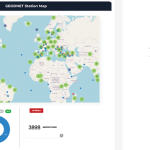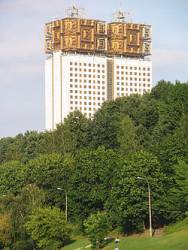Q: What effect does network size have on NRTK positioning?
A: Network real-time kinematic (NRTK) positioning is nowadays a very common practice, not only in academia but also in the professional world. In the last 10 years, several networks of continuous operating reference stations (CORSs) were created to support users. These networks offer real-time services for NRTK positioning, providing centimeter-level positioning accuracy with an average distance of 25–35 kilometers between the reference stations.
Q: What effect does network size have on NRTK positioning?
A: Network real-time kinematic (NRTK) positioning is nowadays a very common practice, not only in academia but also in the professional world. In the last 10 years, several networks of continuous operating reference stations (CORSs) were created to support users. These networks offer real-time services for NRTK positioning, providing centimeter-level positioning accuracy with an average distance of 25–35 kilometers between the reference stations.
The benefits of NRTK positioning and the details of network products have been presented previously in this column (see the contributions by Paul Alves in the July/August 2008 issue and by Leila Kislig in the July/August 2011 issue), and therefore are not discussed here. However, because GNSS measurement errors are spatially correlated, the quality of the error estimates degrades as a function of spacing between the reference stations of the network.
So, what is the effective distance between reference stations that enables the precision required for real-time positioning, using multi-frequency, multi-constellation receivers? Also, how does the position accuracy change with increasing distances between CORS?
We carried out some experiments to answer these questions.
The experiments were conducted using, as the rover site, a metallic pillar on the roof of the Politecnico di Torino at Vercelli, Italy. We selected reference stations belonging to networks operated by administrative entities and private organizations in northwestern Italy so that the rover could be near the centroid point with respect to the three different GNSS networks, as shown in Figure 1 (see inset photo, above right.)
The experiments were based on three different networks, with different inter-station distances: the first one (as reflected in Figure 1 and identified in the following discussion), the “red network” or “small network” with distances of about 50 kilometers, is comparable with existing GNSS European networks designed for RTK purposes. The second (the “green” or “medium” network) is characterized by distances of about 100 kilometers, which is the average spacing of a national-scale geodetic network.
Although these first two networks were designed for post-processing applications (i.e., to materialize a national or international reference system), the possibility of using these for real-time positioning could be very interesting in the future.
The final network considered (the “blue” or “large” network) has inter-station distances of about 150 kilometers. We used it to verify the possibility of operating with considerably sparser networks.
In the experiments, we used multi-frequency, multi-constellation GNSS receivers from three different companies as the rover. Each receiver was connected to its geodetic antenna and mounted on the metallic pillar at the Vercelli site. The tests used three different types of NRTK corrections: a Virtual Reference Station (VRS), a Master Auxiliary Concept (MAC) and a Flächen Korrektur Parameter (FKP).
For each receiver and each NRTK correction, 24 hours of real-time positioning results were computed and stored. Using such long data sets removes the effect of the GPS constellation geometry on the results, thus making them fully comparable with each other.
Although the performance of NRTK positioning also depends on the receiver’s ability to interpolate the network corrections and to successfully resolve ambiguities, the analysis of the acquired data is intended to give insight into the behavior of an “average” receiver. For this reason, for a given scenario, the cumulative distribution functions (CDFs) of the errors (both planimetric/horizontal and height) of each receiver were averaged.
This approach allowed us to assess the behavior of a generic GNSS receiver operating in a network of GNSS reference stations and to analyze the positioning quality with respect to the size of the network. Only the positions with both fixed ambiguities and an HDOP (horizontal dilution of precision) index lower than 4 have been considered in order to exclude outliers from the analysis.
The VRS is without doubt the most used differential correction in real-time positioning. Starting from the network error models, this method seeks to generate a virtual reference station close to the rover position. The error estimation accuracy is therefore expected to degrade as inter-station distances increase. If the inter-station distance is increasing, in fact, numerous inaccuracies can arise in the interpolation step during the generation of the VRS corrections.
Figure 2 shows the average behavior of a multi-frequency, multi-constellation GNSS receiver in the case of a VRS correction broadcast by networks of various sizes. The CDF analysis brings out an effective increase of the errors (both planimetric/horizontal and height) when the size of the GNSS network increases.
The planimetric error, for example, changes from values below 5 centimeters (95% probability) considering the “red” network up to 10 and 15 centimeters with the “green” and the “blue” ones, respectively. A similar behavior can be observed for the elevation error, with values from ranging from 6 centimeters (“red” network) to 10 centimeters (“green” network) and about 25 centimeters (“blue” network).
Another network correction analyzed in these experiments is the MAC. This correction method contains the absolute errors from one reference station (master) and the relative errors for other CORSs within a well-defined cell of the network (auxiliary reference stations). For this reason, this correction should be less sensitive to the variation of GNSS network sizes.
With the MAC approach, as long as the distance between the master station and the rover is shorter than typical values used for real-time differential positioning (about 20–30 kilometers), the variation of the network size represents only a minor contribution to the differential correction, because the increased network size only affects the contribution from to the auxiliary stations (not the master station). The performance when using MAC corrections is summarized in Figure 3.
The curves shown in this figure confirm what we expected. Specifically, we can see how positioning errors do not increase excessively when switching between the “red” and the “green” network. In these cases, the positioning quality is similar, and reaches about 5 centimeters (95% probability) in the horizontal and about 10 centimeters in height.
In contrast, a significant positioning deterioration occurs when MAC corrections broadcasted by the “blue” network are used. In this case, the master station is very far from the rover, causing problems in the quality of the positioning (15 centimeters in the horizontal and 25 centimeters in height).
The final method of differential correction used is the FKP, which consists of broadcasting to the rover the parameters of a regional plane model estimated by the network software. The hypothesis that spatial variations of the errors can be arranged along a plane is certainly reliable for small networks, but becomes overly simplistic when the inter-station distances grow too large. With FKP, in fact, local atmospheric phenomena, which can cause considerable disturbances in the GNSS observations, are not taken into account. The positioning results are shown in Figure 4.
As can be seen, a plane interpolation model allows to achieve a positioning error equal to or slightly greater than 10 centimeters (95% probability) only when small networks (the “red” one) are used. When medium-sized and large-sized networks (the “green” and “blue” ones, respectively) are used, the average horizontal error exceeds 20 centimeters.
A very similar trend is found also for the height error, which increases from 15 centimeters (“red” network) to more than 30 centimeters (“green” and “blue” networks). In this case, no significant differences exist between the two wider networks.
To summarize, multi-frequency, multi-constellation receivers can benefit from the VRS corrections transmitted by networks with inter-station distances up to 100 kilometers, allowing it to achieve horizontal accuracies from 2 to 8 centimeters and from 5 to 12 centimeters in height.
A similar behavior can be found with MAC corrections. This network product, in fact, provides comparable results for the small- and medium-sized networks (about 5 centimeters in the horizontal and 10 centimeters in height).
If large networks are considered, the NRTK positioning is often unacceptable and unreliable. Due to their lower accuracy in modeling biases of large areas, FKP corrections are not suitable for positioning even in medium-sized networks.
Acknowledgements
The experiments were funded as part of the National Research Project PRIN 2008 “The new Italian Geodetic Reference System: continuous monitoring and application of control management of the territory,” financed by the Italian Ministry of Education, University and Research in 2008.
Additional Resources
For more information about MAC, VRS and FKP corrections, please refer to the following papers:
Euler H.J., and C.R. Keenan, B.E. Zebhauser and G. Wübbena, “Study of a simplified approach in utilizing information from permanent reference station arrays”, paper presented at the 14th International Technical Meeting of the Satellite Division of The Institute of Navigation (ION GPS 2001), Salt Lake City (UT-USA), September 2001. (available here, last accessed October 25, 2011)
Landau H., and U. Vollath and X. Chen, “Virtual Reference Station Systems”, Journal of Global Positioning Systems, Vol. 1, No 2:137-143, 2002 (available here, last accessed October 25, 2011).
Wübbena, G., and A. Bagge, “RTCM Message Type 59–FKP for transmission of FKP”, Geo++ White paper, No 2002.01, 2002 (available here, last accessed October 25, 2011)





